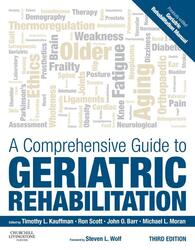「重要なお知らせ:日本語書籍をご購入いただき、eLibraryをご利用の皆さまへ」
エルゼビアは、より快適にサービスをご利用いただくため、システムの重要なアップデートを実施いたします。
現在、新サイト、eBooks+への移行が進められています。
新規ユーザー登録および書籍の登録はElsevier eLibraryでは停止しております。
12月15日以降に
こちらよりご利用・ご登録ください。
A Comprehensive Guide to Geriatric Rehabilitation E-Book






Book Description
Now in its third edition, this trusted clinical guide enables both the busy practitioner and student to review or to learn about a range of pathologies, conditions, examinations, diagnostic procedures, and interventions that can be effectively used in the physical rehabilitation of older people. It presents a broad overview of age-related physiological changes as well as specific professional discipline perspectives.
Organized into eleven distinct and interrelated units, the first unit begins with key anatomical and physiological considerations seen with aging which have significant impact on the older person. The second and third units go on to review important aging-related conditions and disorders of the musculoskeletal and neuromuscular/neurological systems respectively. Neoplasms commonly encountered in older people are the focus of the fourth unit; while aging-related conditions of the cardiovascular, pulmonary, integumentary and sensory systems are presented in units five through seven. Unit eight highlights a range of specific clinical problems and conditions commonly encountered with older patients.
Critically, all of these units emphasize important examination and diagnostic procedures needed for a thorough evaluation and stress interventions that can be of significant benefit to the older patient. The ninth unit presents select physical therapeutic interventions that are especially important in managing rehabilitative care. Key societal issues related to aging are discussed in the tenth unit. Finally, the concluding eleventh unit focuses on the successful rehabilitation team that includes both professional and non-professional caregiver members.
-
- A trusted guide to the conditions and problems faced when evaluating and treating geriatric patients
- Extensive coverage over 84 chapters, each written by an expert in the field
- Includes imaging, vision and the aging ear
- Cross-referenced - providing the complexity and inter-relatedness of co-morbidities common to aging patients
- Collaborative international perspective
- Chapters on the aging spine; frailty; safe pilates for bone health; health care for older people
- Additional renowned editor - Ronald W. Scott
- Revised title to reflect the comprehensive scope of content covered (previously entitled Geriatric Rehabilitation Manual)


 (0 rating)
(0 rating) 